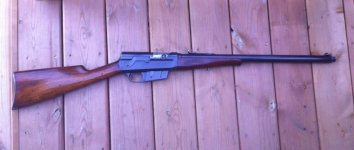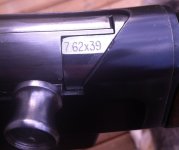You are using an out of date browser. It may not display this or other websites correctly.
You should upgrade or use an alternative browser.
You should upgrade or use an alternative browser.
Remington Model 8 love out there?
- Thread starter .22LRGUY
- Start date
In case anyone is unfamiliar with what tiriaq is describing, here is a picture showing the muzzle of the barrel and the barrel nut (threaded on the the end of the barrel) and the barrel bushing which threads in the the barrel jacket jacket keeping the recoil spring in place.To remove the barrel, a tool has to be made to unscrew the muzzle nut. Another tool is needed if the barrel return spring and buffer assembly are to be removed.
Theres a bit more to it but thats the gist!
Remington supplied a little C-spanner with each rifle. Most are long gone. I took a large hex nut, bored it to a smooth fit on the barrel nut, then drilled and tapped a 6-48 hole in one of the flats. Turned down the end of a 6-48 screw to fit the hole in the barrel nut. Grabbed the hex nut in the vise, and turned the barrel nut off.
A word of caution - same of these rifles have never had the barrel nut removed since leaving Ilion, 75 to 120 years ago. The barrel nut may not want to unscrew. Use a good penetrant and a tool that will grip the barrel nut without damage.
A word of caution - same of these rifles have never had the barrel nut removed since leaving Ilion, 75 to 120 years ago. The barrel nut may not want to unscrew. Use a good penetrant and a tool that will grip the barrel nut without damage.
A while back I got a call from the local sporting goods shop - customer had brought in a rifle and they did not know what ammunition it used. It was a FN made auto, stamped 9mm. .35 Remington, of course. It was in very respectable condition, made with the attention to detail found in pre WW1 firearms. Not for sale of course.
Model 8/81 rifles in .300 Savage and .35 Remington command a premium. Getting .25, .30 and .32 ammunition requires effort, either searching for original cartridges or handloading. Which can require reworking available cases. .25, 30 and .32 Winchester cases can be converted from rimmed to rimless; loading data is the same. I've never tried altering cases to rimless, but it requires a lathe, time and patience. One case at a time. A batch of 100 would be a bit of an ordeal...
All 8s and 81 have substantially increased in value the last few years, even the ones in .25, .30 and .32.
Good shooting grade rifles do turn up, at a price.
As an aside, look at the trials and tribulations Canadian makers have gone through trying to produce solid working rifles based on the AR-180B system. A 180 is child's play compared with one of these Browning designed long recoil autos. Complicated parts with intricate contours, whittled from solid steel. These rifle enjoyed a reputation for reliability.
Model 8/81 rifles in .300 Savage and .35 Remington command a premium. Getting .25, .30 and .32 ammunition requires effort, either searching for original cartridges or handloading. Which can require reworking available cases. .25, 30 and .32 Winchester cases can be converted from rimmed to rimless; loading data is the same. I've never tried altering cases to rimless, but it requires a lathe, time and patience. One case at a time. A batch of 100 would be a bit of an ordeal...
All 8s and 81 have substantially increased in value the last few years, even the ones in .25, .30 and .32.
Good shooting grade rifles do turn up, at a price.
As an aside, look at the trials and tribulations Canadian makers have gone through trying to produce solid working rifles based on the AR-180B system. A 180 is child's play compared with one of these Browning designed long recoil autos. Complicated parts with intricate contours, whittled from solid steel. These rifle enjoyed a reputation for reliability.
Here is a couple of pretty nice FN1900s, the European cousin of the Model 8
(click on link to see photos)
Last edited:
Blastattack
CGN Ultra frequent flyer
- Location
- Winnipeg MB
I’d love a decent 1900. That ribbed barrel is super cool.Here is a couple of pretty nice FN1900s, the European cousin of the Model 8
(click on link to see photos)
The lathe, used as a shaper, cut a beautiful slot, fitting the nub in the ratchet disc perfectly.Spent a couple of hours at the lathe this afternoon roughing out the new barrel. I'd planned on starting with a take-off sporter weight. But all the ones in the rack were 22", and the Model 8 barrel is 22". Too short, the original chamber needing to be cut off. Found a new semi finished barrel, long enough, but also target weight. Cut a 23" portion, and turned the breech end to 7/8". Reversed, and started taking the muzzle end down. Its at about .600" now, not too much more to remove. Once it is down to size, I'll reverse again, and taper the breech section to blend with the small diameter muzzle end. Then cut the breech and muzzle threads, and fit the barrel extension and muzzle nut. I think the pile of swarf in the chip pan will weigh about as much as the finished barrel.
In the video above, Mark Novak made reference to the longitudinal groove in the barrel which engages the ratchet washer. I've been pondering how to cut the groove. Rather than using a very small end mill (which I would have to order), I think I will cut the groove using the lathe as a shaper. Mount the barrel between chuck and tail center, lock the spindle, mount a cutter in the tool post, then manually use longitudinal carriage travel to scrape cut the groove.
Ground a tool to the desired shape, and used the longitudinal motion of the carriage to run the cutter along the barrel. Made scrape cuts. .003" deep, continuing until the groove was complete.
Dismantled the action. The stripped bolt turns to locked position in the barrel extension; makes contact on the abutments and barrel face. Will shave a bit off the barrel face to give slight clearance. The barrel must now be chambered, and feed ramp and extractor cuts made. Bolt face recess will need to be opened to accept the .447" diameter 7.62 case. .30 Rem. head diameter is .421". The 7.62 is only 26 thou larger in diameter.
Looking at the machining that went into manufacture of these rifles, I am impressed that Remington made in excess of a hundred thousand of them.








































































